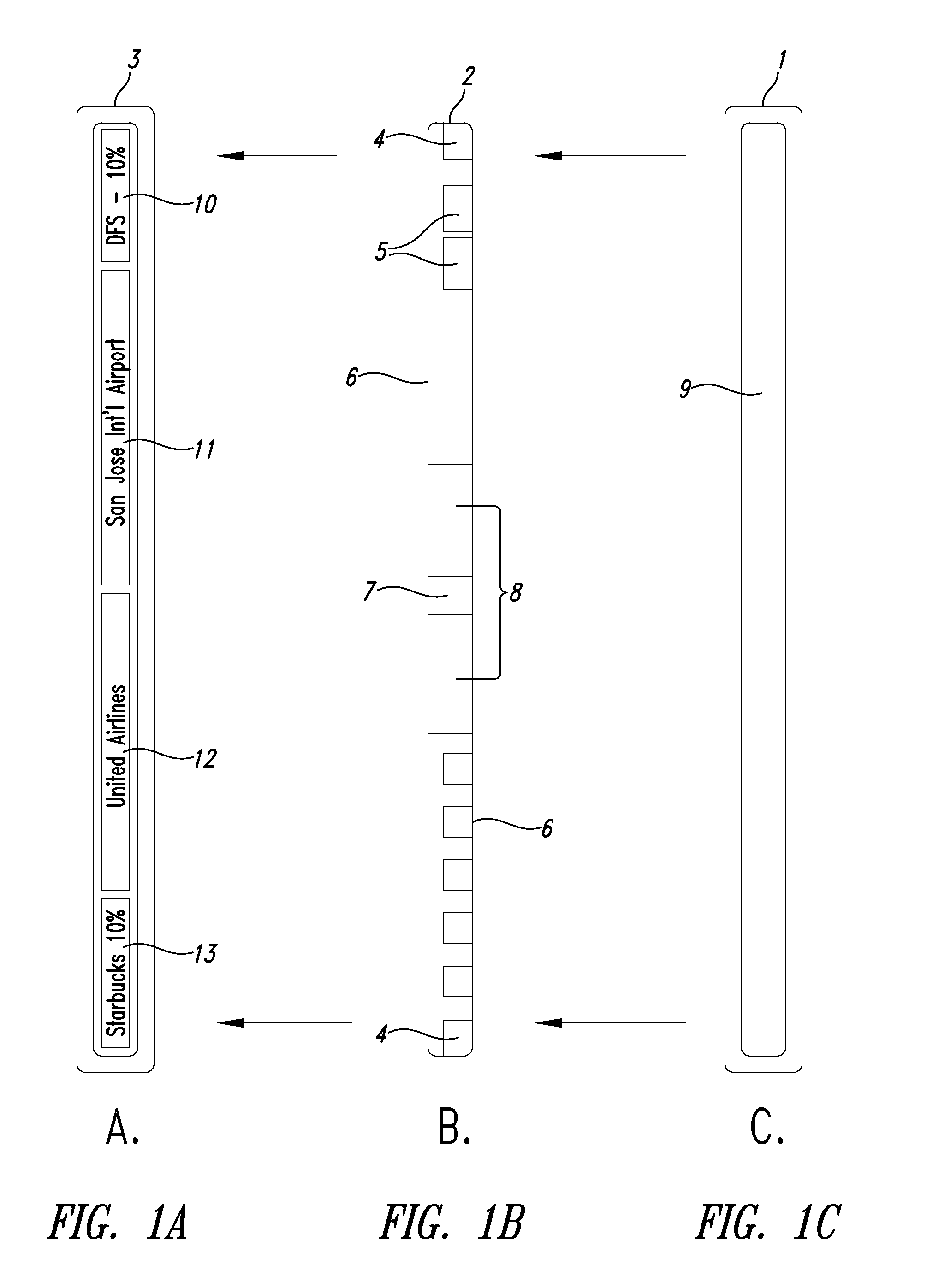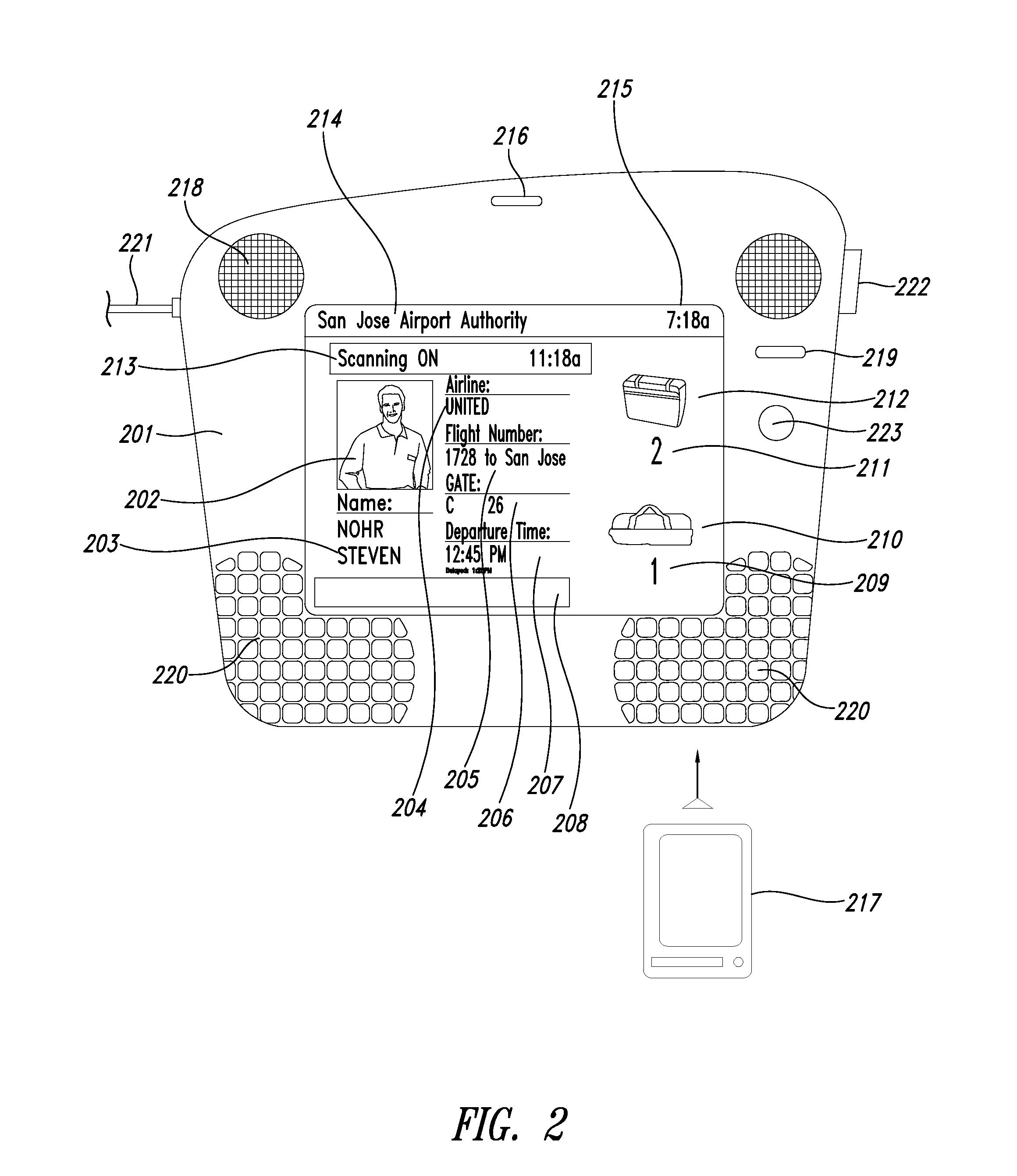All of the prior designs and proposed solutions at best only provide a small portion of the necessary functions, features, and demands that are required by an environment, such as an airport environment of today.
U.S. Pat. No. 6,342,836 B2 Zimmerman Jan. 29, 2002: patent and product only provides a limited capability for passengers to know if their luggage is loaded below the
airplane that the passenger is departing on, and a limited capability of knowing only the precise time that the baggage comes out of the baggage claim carousel belt.
Other than that, this patent cannot provide the host of
access control, tracking, monitoring, services, and other features that airlines and airports require in this day and age.
This patents PED
transmitter and
transponder controller product has little to no enhanced security features to protect such an environment from any terrorist event, nor is it able to automatically and non-unobtrusively detect, without human interpretation, and without regard to shape or method of concealment the location of any persons, carry-on baggage, or
exact location of a checked-in baggage at any point in time, nor can it provide passenger, or airport, airline personnel information profiles by use of various forms of hardware devices, as provided in FIG. 2, FIG. 3, FIG. 4, FIG. 5, and FIG. 7 not only at
access control points, but more importantly anywhere in and around an airport,
airplane, or
aviation environment.
This patent is unable to provide or achieve all or most of the items listed above (a) to (r), nor is this
system able to provide the host of functions and features listed on the key advantages of this filed patent hereto, or any type of information, or services to at least one user.
U.S. Pat. No. 6,338,041 B1 Kawamata Jan. 8, 2002: patent and product does have a means of issuing paper tickets accompanies by a tag, which can be utilized to collect and update information at primary
access control points, and providing the necessary equipment to
ticket counter staff, screening areas, and boarding gate areas, however does not provide a means to eliminate bait-and-switch, piggybacking, can't facilitate matching techniques, a host of services that can be provided to passengers, pick up party, and persons, can't identify and know when a passenger leaves their boarding pass and associated tag in the trash or walking away, can't quickly and unobtrusively query a passenger by a security personnel while mobile in such environment, can't identify or know when or if passenger and carry-on baggage is separated, and a host of additional functions and features as highlighted in the present invention.
1. The prior art does not track checked-in baggage,
2. The prior art does not track carry-on baggage,
3. The prior art does not eliminate ‘bait and switch’ tactics,
4. The prior art does not provide information services to travelers,
5. The prior art does not allow security personnel to randomly identify passengers / airport / airlines personnel while mobility moving around,
6. The prior art does not know if or how may checked baggage has been checked in by a passenger, carry-on baggage, or able to match baggage to persons, or persons to baggage,
7. The prior art does not know where passengers checked-in luggage is,
8. The prior art does not know if or where a passengers carry-on baggage is,
9. The prior art can't confirm whether a passenger boarding an
airplane has left their carry-on baggage in the airport, is the owner of another passenger, or more,
The prior art can't prevent the passenger from just leaving their smartcard of
swipe card in the trash, since it is not secured, attached, or adhered to the passenger in any way, nor having a means of informing other parties in such an event,
The prior art can't quickly identify which checked-in luggage that has been loaded into the underbelly of an airplane belongs to which passenger who did not board the airplane, (for quick removal, so the airplane can depart on schedule),
The prior art can't identify and track passengers and carry-on baggage activities throughout an airport, airplane, or aviation environment,
The prior art can't provide data and information to passengers (about their flight, activities, ETA, checked-in baggage, message boards, sending messages to parties outside the airport environment, to a party in the
parking area, and much more,
The prior art doesn't provide a secure method to ensure passengers / airport / airlines personnel actually carry or bring their smartcard with them at all times,
The prior art doesn't have a means of activating and deactivating their smartcard,
The prior art doesn't know where or if the passenger leaves its smartcard laying around, only at the time the passenger attempts to board an airplane,
The prior art can't provide (ETA) information how long before the passengers luggage will arrive to the carousel area,
The prior art doesn't provide a means for audible and visual information informing the passenger when its luggage bags start
coming out of the carousel,
The prior art doesn't provide a means for the passenger or traveler to notify a pick up party they have arrived, nor how long till they come out, or where to meet,
The prior art doesn't know where the passengers pick up arty is located,
The prior art can't invalidate a passenger who exists an airport environment, preventing them form re-entering,
The prior art can't track airport tenants, merchandise, or other coming in or going out of such controlled environment,
The prior art can't provide time, audit, and attendance on airport, airlines, and other personnel,
The prior art can't eliminate theft of smartcards or
swipe cards which are very expensive to use.
It is not realistic to force passengers to return PASScards if not they can't exit an airport.
The prior art can't automatically calculate and determine where passengers who have not yet boarded are located, including their carry-on baggage, and even contacting them in that specific location, nor no luggage tracking or
handling system,
The prior art has no means of activating, affixing, or attaching such identification tag to a person, object or alike, so that it cannot be removed, or it in the event of remove, invalidation can occur, and immediately be known to external sources.
The prior art equally utilizes a central data storage center, and does not offer or provide terminals, or portable hardware devices with all its attributes.
7. the prior art cannot identify and / or eliminate ‘bait and switch’ tactics,
8. the prior art cannot identify and / or eliminate ‘piggybacking’ tactics,
9. the prior art cannot identify and / or provide ‘matching techniques’,
10. the prior art cannot immediately provide to an authorized querying party, related data and information on a subject, such as a person or object, but rather can only come from a (CPU)
systemIn such an event, the prior art would quickly and efficiently be rendered useless, and not be able to ID, track, monitor, locate, authorize, or make known whom is whom, whether the user / passenger is indeed who they claim to be, where their bags are located, if it is indeed their bags that they are carrying, who is existing the
system, who has not yet existed the system, how many people are still in the system, where they are located, and so much more.
The basic questions that any ‘intelligence agent’ upon arriving to such a situation must immediately access and collect to provide to its superiors in order to grasp the magnitude of the current situation, to implement some type of
damage control, would be impossible to achieve with the prior art.
34. the prior art is not able to provide any type of enhancements to any type of building
security system, whereby objects are tagged and if moved from its current location, moved out of a respective room, moved out of a respective building, or alike the building
security system can trigger an alarm system, can inform a CMS (central monitoring
station), or at least one party or system of such incidence is occurring, by wired and / or
wireless means, systems, and / or networks as well as creating and
logging in such an event under a time, audit, and attendance systems
software, or sending such notification to the owner, in the form of a phone call, or cellular phone call,
38. the prior art does not enable pick up parties, and / or drop off parties to communicate with the passenger(s) while they are within the airport environment.
The prior art can match passenger to checked-in baggage and baggage to passenger, however such information cannot easily be acquired unobtrusively and throughout an airport and airline environment, not can be activated, invalidated, or secured to the person, or object.
Moreover, the prior art is unable to provide a host of functions, features, monitoring of passengers, carry-on baggage, bait-and-switch tactics, piggybacking tactics, and a host of security, tracking, unique features described to the bracelet and / or sticker apparatus,
passenger information services, and pick up party services to name a few.
 Login to View More
Login to View More  Login to View More
Login to View More 


